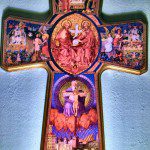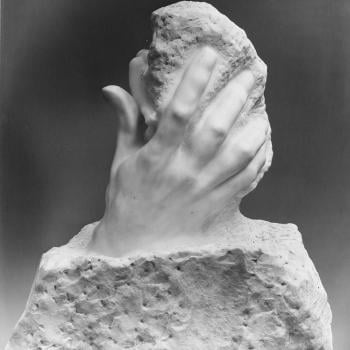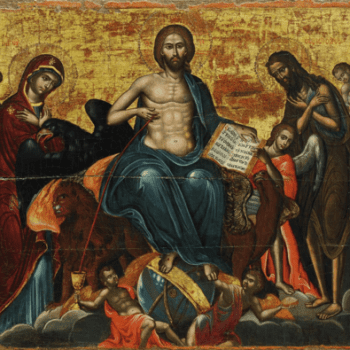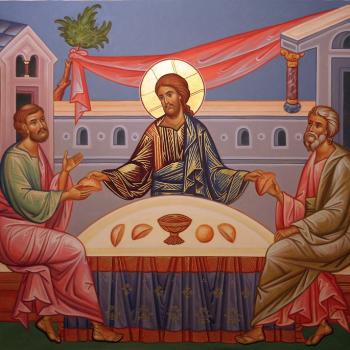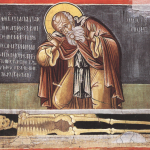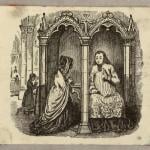
We have grown so accustomed to ignore the symbolic aspect of the sacraments that many believe that there is nothing symbolic about them. Traditionally, not only was the symbolic aspect of the sacraments understood, it was embraced, leading to all kinds of explorations as to how the symbols could and should be interpreted. Indeed, it was accepted that the symbolic side was necessary for us because the sacraments contained within them transcendent mysteries which the symbols helped us apprehend. We gain a better appreciation of what it is we receive by exploring and engaging the symbols connected with the sacraments. For example, as baptism washes us clean on the outside, we can understand how the grace imparted through it cleanses us from sin. When baptism is done by immersion, we can also see symbolized through the procedure the way we are to die to the self and come back to life in Christ.
When we understand that there is always a symbolic side to the way we engage sacraments, we will not confuse what we see and experience with the sense as being the full extent of the sacraments. We will have learned to accept that we are being pointed to various truths through what we see and experience instead of assuming what we apprehend through our experience is the fullness of the truth itself. Accepting, therefore, that the physical action and reception of the sacraments presents to us symbols to contemplate, we should be able to better appreciate the sacraments and what we are being given by them. That is, we will understand that we are given signs of the reality which is contained in the sacraments, a reality which transcends our comprehension. If we try to make the sacraments as something simple and easily comprehensible, we make them seem as if they are something common, and in doing so, we should not be surprised that people will not appreciate the mystery at work and turn away from them. We must, rather, follow the ancient wisdom, recognizing the way sacraments contain sacred signs, as Lanfranc of Canterbury wrote:
We believe the sacrament about which we are talking to be a sacred sign, and urge that it is believed as such. In this sign, beyond the appearance which impresses itself on the eyes of those who are looking, something far other and very different salubriously comes to the thought of those who perceive it. What that reality would be, however, or further, what those things are which I have briefly called to mind above, I will give a more expanded explanation on a little later. [1]
The eucharist comes to us in the form of bread and wine. Different liturgical traditions, different rites, will use different kinds of bread for the eucharist. Some will use unleavened bread, while others will use leavened bread. Both traditions look to the kind of bread being used as a way to signify some greater truth. Those using unleavened bread suggested the unleavened nature of the bread symbolizes freedom from sin, that the body of Christ is a sinless body, no longer having the leaven of sin. Those who use leavened bread, however, see the leavening not as sin, but as grace, that is, what the incarnate God-man brings to the world to transform it and make it something greater than it was before. Both liturgical forms, and the ways their liturgical forms can be interpreted, have value, and each, in their own way, point to something about the reality of the eucharist itself. The unleavened bread points to the mystical body of Christ which is established in and through communion, while the leavened bread signifies how the incarnation brought the leaven of grace to the world. St. Albert the Great, however, pointed out another way the physical qualities of the eucharist symbolize or signify what it is we receive: “And I say, they are in the sacraments in this way, around the body of Christ, veiling it, and signifying that he is true food.”[2] For what we receive is the food and drink which is Christ himself, the bread which came down from heaven, the food we need, not just for normal nutrition, and the continuation of our daily existence, but for eternal life. We become what we eat, so that, paradoxically, we are then taken in and converted by Christ, becoming one with him, and it is through such unity we are granted our participation in the divine life itself.
Understanding this, understanding that what we see is not what we get, but rather, what we get lies hidden beyond our senses, we should appreciate the symbolic nature of the sacraments, that is, their physical form contains within it all kinds of symbolic meanings which we should try to ascertain. In doing so, we will move beyond the simple, materialistic approach to the sacraments which suggests that there is nothing special about them. Instead, they indicate that what we have, what we sense, are mere veils, veils which hide the transcendent reality from us. We can, and then, should use the symbols to help us contemplate what we receive, and in doing so, we will realize in the eucharist, the sacramental presence of Jesus means he can and does sense us through the sacrament even if we ourselves do not see him:
He is with us, veiled by the wall of the sacramental species, gazing upon our devotion, and looking upon us in an unveiled manner through the windows. [Song 2.9] “Behold, he stands behind our wall, looking through the windows, gazing through the lattices.” While looking through the latices or the windows, he is not seen while he sees. And so, in this sacrament, the Lord sees us, although he is not seen by us. Now these are the windows, through which truth is brought to us in the sacrament, and the lattices, through which the goodness of Christ’s virtues shines upon us, by the paths Christ directs the rays of his light to us, although we do not see him except as veiled. [3]
A confused understanding of communion, one which is overtly physical, one which confuses the accidents, the physical form, with the substance, undermines the sacrament, as it is clear what we physically receive is bread and wine. By ignoring the symbolic side of the sacrament, many have come to believe there is no symbol involved. They come to think of the eucharist in ways which run contrary to its proper appreciation, and so, it is easy to see why many reject it, because all they sense is bread and wine. The richness of communion certainly lies with Christ; he truly comes to us in a sacramental presence, but it is also a richness which includes all that Christ has used to bring this about that presence, including the material, physical form, and the rich, symbolic elements which can be discerned in that physical form. We need to learn to appreciate symbols, for when we do so, we will not be so literal minded, not so simple in our approach to the world, and we will find, as a result, a much bigger, grandeur, beautiful world lies before us, even as in and that world, we find a richer, more dynamic relationship with God.
[1] Lanfranc of Canterbury, “On the Body and Blood of the Lord” in Lanfranc of Canterbury: On the Body and Blood of the Lord and Guitmund of Aversa: On The Truth of the Body and Blood of Christ in the Eucharist. Trans. Mark G. Vaillancourt (Washington, DC: Catholic University of America Press, 2009), 53.
[2] St. Albert the Great, On the Body of the Lord. Trans. Sr. Albert Marie Surmanski, OP (Washington, DC: CUA Press, 2017), 234.
[3] St. Albert the Great, On the Body of the Lord, 243.
Stay in touch! Like A Little Bit of Nothing on Facebook.
If you liked what you read, please consider sharing it with your friends and family!
N.B.: While I read comments to moderate them, I rarely respond to them. If I don’t respond to your comment directly, don’t assume I am unthankful for it. I appreciate it. But I want readers to feel free to ask questions, and hopefully, dialogue with each other. I have shared what I wanted to say, though some responses will get a brief reply by me, or, if I find it interesting and something I can engage fully, as the foundation for another post. I have had many posts inspired or improved upon thanks to my readers.


